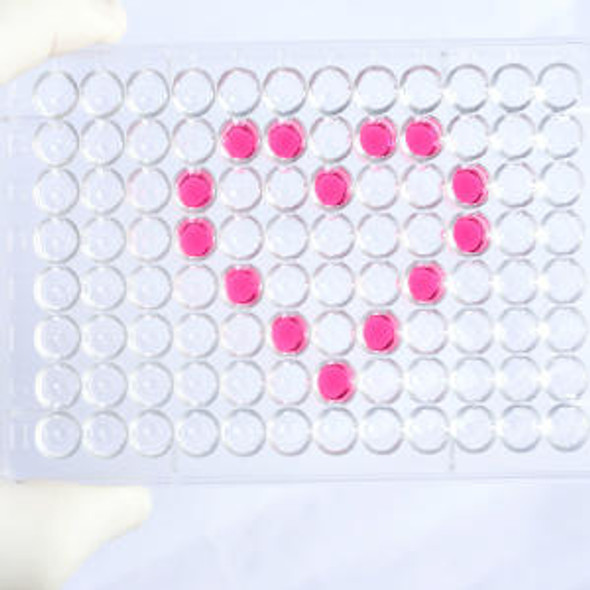Human Cell Biology ELISA Kits 6
Human EPHA3 (Ephrin Type A Receptor 3) ELISA Kit (HUES02154)
- SKU:
- HUES02154
- Product Type:
- ELISA Kit
- Size:
- 96 Assays
- Uniprot:
- P29320
- Sensitivity:
- 0.19ng/mL
- Range:
- 0.31-20ng/mL
- ELISA Type:
- Sandwich
- Reactivity:
- Human
- Sample Type:
- Serum, plasma and other biological fluids
- Research Area:
- Cell Biology
Description
| Assay type: | Sandwich |
| Format: | 96T |
| Assay time: | 4.5h |
| Reactivity: | Human |
| Detection Method: | Colormetric |
| Detection Range: | 0.31-20 ng/mL |
| Sensitivity: | 0.19 ng/mL |
| Sample Volume Required Per Well: | 100µL |
| Sample Type: | Serum, plasma and other biological fluids |
| Specificity: | This kit recognizes Human EPHA3 in samples. No significant cross-reactivity or interference between Human EPHA3 and analogues was observed. |
This ELISA kit uses Sandwich-ELISA as the method. The micro ELISA plate provided in this kit has been pre-coated with an antibody specific to Human EPHA3. Standards or samples are added to the appropriate micro ELISA plate wells and combined with the specific antibody. Then a biotinylated detection antibody specific for Human EPHA3 and Avidin-Horseradish Peroxidase (HRP) conjugate are added to each micro plate well successively and incubated. Free components are washed away. The substrate solution is added to each well. Only those wells that contain Human EPHA3, biotinylated detection antibody and Avidin-HRP conjugate will appear blue in color. The enzyme-substrate reaction is terminated by adding Stop Solution and the color turns yellow. The optical density (OD) is measured spectrophotometrically at a wavelength of 450 nm ± 2 nm. The OD value is proportional to the concentration of Human EPHA3. The concentration of Human EPHA3 in samples can be calculated by comparing the OD of the samples to the standard curve.
| UniProt Protein Function: | EphA3: a receptor tyrosine kinase of the Eph family. Receptor for members of the ephrin-A family: binds to ephrin-A2, -A3, -A4 and -A5The Eph receptor tyrosine kinase family, the largest in the tyrosine kinase group, has fourteen members. They bind membrane-anchored ligands, ephrins, at sites of cell-cell contact, regulating the repulsion and adhesion of cells that underlie the establishment, maintenance, and remodeling of patterns of cellular organization. Eph signals are particularly important in regulating cell adhesion and cell migration during development, axon guidance, homeostasis and disease. EphA receptors bind to GPI-anchored ephrin-A ligands, while EphB receptors bind to ephrin-B proteins that have a transmembrane and cytoplasmic domain. Interactions between EphB receptor kinases and ephrin-B proteins transduce signals bidirectionally, signaling to both interacting cell types. Eph receptors and ephrins also regulate the adhesion of endothelial cells and are required for the remodeling of blood vessels. Two point mutations seen in a survey of colorectal tumors. Soluble receptors reduce tumor growth and angiogenesis in mouse models. Two alternatively spliced isoforms of EphA3 have been described. |
| UniProt Protein Details: | Protein type:EC 2. 7. 10. 1; Protein kinase, tyrosine (receptor); Protein kinase, TK; Membrane protein, integral; Kinase, protein; TK group; Eph family Chromosomal Location of Human Ortholog: 3p11. 2 Cellular Component: early endosome; extracellular region; integral to plasma membrane; plasma membrane Molecular Function:ATP binding; GPI-linked ephrin receptor activity; protein binding Biological Process: cell adhesion; cell migration; ephrin receptor signaling pathway; peptidyl-tyrosine phosphorylation; regulation of actin cytoskeleton organization and biogenesis; regulation of focal adhesion formation; regulation of GTPase activity |
| NCBI Summary: | This gene belongs to the ephrin receptor subfamily of the protein-tyrosine kinase family. EPH and EPH-related receptors have been implicated in mediating developmental events, particularly in the nervous system. Receptors in the EPH subfamily typically have a single kinase domain and an extracellular region containing a Cys-rich domain and 2 fibronectin type III repeats. The ephrin receptors are divided into 2 groups based on the similarity of their extracellular domain sequences and their affinities for binding ephrin-A and ephrin-B ligands. This gene encodes a protein that binds ephrin-A ligands. Two alternatively spliced transcript variants have been described for this gene. [provided by RefSeq, Jul 2008] |
| UniProt Code: | P29320 |
| NCBI GenInfo Identifier: | 116241351 |
| NCBI Gene ID: | 2042 |
| NCBI Accession: | P29320. 2 |
| UniProt Secondary Accession: | P29320,Q9H2V3, Q9H2V4, |
| UniProt Related Accession: | P29320 |
| Molecular Weight: | 60,946 Da |
| NCBI Full Name: | Ephrin type-A receptor 3 |
| NCBI Synonym Full Names: | EPH receptor A3 |
| NCBI Official Symbol: | EPHA3 |
| NCBI Official Synonym Symbols: | EK4; ETK; HEK; ETK1; HEK4; TYRO4 |
| NCBI Protein Information: | ephrin type-A receptor 3 |
| UniProt Protein Name: | Ephrin type-A receptor 3 |
| UniProt Synonym Protein Names: | EPH-like kinase 4; EK4; hEK4; HEK; Human embryo kinase; Tyrosine-protein kinase TYRO4; Tyrosine-protein kinase receptor ETK1; Eph-like tyrosine kinase 1 |
| Protein Family: | Ephrin type-A receptor |
| UniProt Gene Name: | EPHA3 |
| UniProt Entry Name: | EPHA3_HUMAN |
As the OD values of the standard curve may vary according to the conditions of the actual assay performance (e. g. operator, pipetting technique, washing technique or temperature effects), the operator should establish a standard curve for each test. Typical standard curve and data is provided below for reference only.
| Concentration (ng/mL) | O.D | Average | Corrected |
| 20 | 2.389 2.439 | 2.414 | 2.33 |
| 10 | 1.57 1.594 | 1.582 | 1.498 |
| 5 | 0.898 0.882 | 0.89 | 0.806 |
| 2.5 | 0.508 0.514 | 0.511 | 0.427 |
| 1.25 | 0.282 0.276 | 0.279 | 0.195 |
| 0.63 | 0.19 0.174 | 0.182 | 0.098 |
| 0.31 | 0.125 0.143 | 0.134 | 0.05 |
| 0 | 0.083 0.085 | 0.084 | -- |
Precision
Intra-assay Precision (Precision within an assay): 3 samples with low, mid range and high level Human EPHA3 were tested 20 times on one plate, respectively.
Inter-assay Precision (Precision between assays): 3 samples with low, mid range and high level Human EPHA3 were tested on 3 different plates, 20 replicates in each plate.
| Intra-assay Precision | Inter-assay Precision | |||||
| Sample | 1 | 2 | 3 | 1 | 2 | 3 |
| n | 20 | 20 | 20 | 20 | 20 | 20 |
| Mean (ng/mL) | 1.07 | 2.12 | 8.98 | 1.08 | 1.99 | 9.50 |
| Standard deviation | 0.06 | 0.12 | 0.31 | 0.07 | 0.08 | 0.29 |
| C V (%) | 5.61 | 5.66 | 3.45 | 6.48 | 4.02 | 3.05 |
Recovery
The recovery of Human EPHA3 spiked at three different levels in samples throughout the range of the assay was evaluated in various matrices.
| Sample Type | Range (%) | Average Recovery (%) |
| Serum (n=5) | 86-97 | 91 |
| EDTA plasma (n=5) | 89-104 | 96 |
| Cell culture media (n=5) | 88-102 | 95 |
Linearity
Samples were spiked with high concentrations of Human EPHA3 and diluted with Reference Standard & Sample Diluent to produce samples with values within the range of the assay.
| Serum (n=5) | EDTA plasma (n=5) | Cell culture media (n=5) | ||
| 1:2 | Range (%) | 98-111 | 92-105 | 85-97 |
| Average (%) | 105 | 98 | 90 | |
| 1:4 | Range (%) | 90-103 | 84-98 | 86-99 |
| Average (%) | 97 | 90 | 92 | |
| 1:8 | Range (%) | 87-102 | 78-92 | 83-97 |
| Average (%) | 94 | 85 | 89 | |
| 1:16 | Range (%) | 87-102 | 86-97 | 82-94 |
| Average (%) | 93 | 92 | 87 |
An unopened kit can be stored at 4°C for 1 month. If the kit is not used within 1 month, store the items separately according to the following conditions once the kit is received.
| Item | Specifications | Storage |
| Micro ELISA Plate(Dismountable) | 8 wells ×12 strips | -20°C, 6 months |
| Reference Standard | 2 vials | |
| Concentrated Biotinylated Detection Ab (100×) | 1 vial, 120 µL | |
| Concentrated HRP Conjugate (100×) | 1 vial, 120 µL | -20°C(shading light), 6 months |
| Reference Standard & Sample Diluent | 1 vial, 20 mL | 4°C, 6 months |
| Biotinylated Detection Ab Diluent | 1 vial, 14 mL | |
| HRP Conjugate Diluent | 1 vial, 14 mL | |
| Concentrated Wash Buffer (25×) | 1 vial, 30 mL | |
| Substrate Reagent | 1 vial, 10 mL | 4°C(shading light) |
| Stop Solution | 1 vial, 10 mL | 4°C |
| Plate Sealer | 5 pieces | |
| Product Description | 1 copy | |
| Certificate of Analysis | 1 copy |
- Set standard, test sample and control (zero) wells on the pre-coated plate and record theirpositions. It is recommended to measure each standard and sample in duplicate. Note: addall solutions to the bottom of the plate wells while avoiding contact with the well walls. Ensuresolutions do not foam when adding to the wells.
- Aliquot 100 µL of standard solutions into the standard wells.
- Add 100 µL of Sample / Standard dilution buffer into the control (zero) well.
- Add 100 µL of properly diluted sample (serum, plasma, tissue homogenates and otherbiological fluids) into test sample wells.
- Cover the plate with the sealer provided in the kit and incubate for 90 min at 37 °C.
- Aspirate the liquid from each well, do not wash. Immediately add 100 µL of BiotinylatedDetection Ab working solution to each well. Cover the plate with a plate seal and gently mix. Incubate for 1 hour at 37 °C.
- Aspirate or decant the solution from the plate and add 350 µL of wash buffer to each welland incubate for 1-2 minutes at room temperature. Aspirate the solution from each well andclap the plate on absorbent filter paper to dry. Repeat this process 3 times. Note: a microplatewasher can be used in this step and other wash steps.
- Add 100 µL of HRP Conjugate working solution to each well. Cover with a plate seal andincubate for 30 min at 37 °C.
- Aspirate or decant the solution from each well. Repeat the wash process for five times asconducted in step 7.
- Add 90 µL of Substrate Reagent to each well. Cover with a new plate seal and incubate forapproximately 15 min at 37 °C. Protect the plate from light. Note: the reaction time can beshortened or extended according to the actual color change, but not by more than 30min.
- Add 50 µL of Stop Solution to each well. Note: Adding the stop solution should be done inthe same order as the substrate solution.
- Determine the optical density (OD value) of each well immediately with a microplate readerset at 450 nm.






